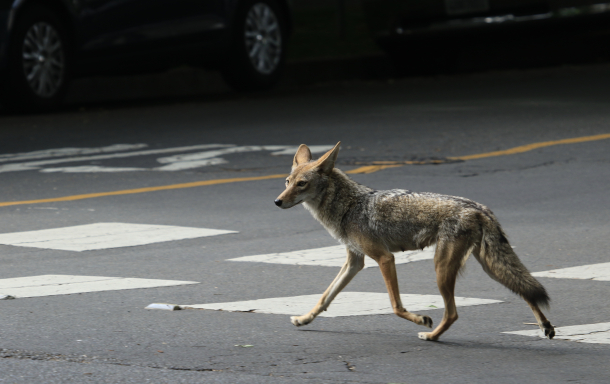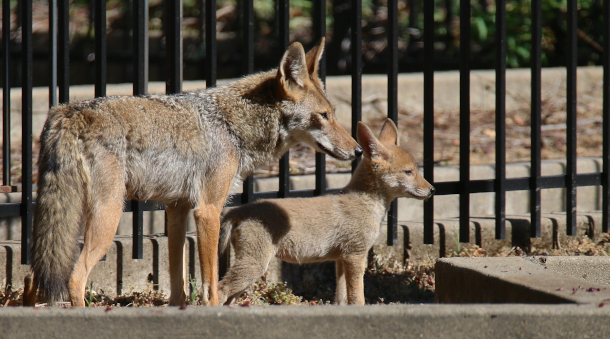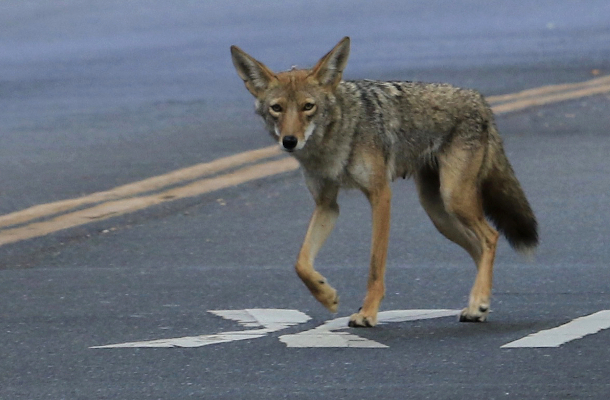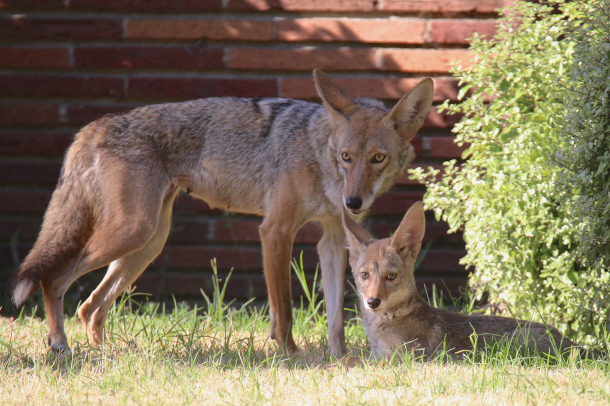Midtown Coyote
Air Date: Week of July 2, 2021

The coyote darts across a street in Sacramento. (Photo: Jennifer Berry Junghans)
In an era of remote learning and spotty Zoom meetings, we humans still have it easier than many animals trying to raise their young. Writer Jennifer Berry Junghans on how a mother coyote manages to eke out a living in the heart of California’s capitol.
Transcript
BASCOMB: Isolating during the pandemic put a spotlight on the challenges of parenting in the absence of childcare. Still, we humans probably have it easier than many animals trying to raise their young. Here’s writer Jennifer Berry Junghans on how a mother coyote manages to eke out a living in the heart of California’s capitol.
JUNGHANS: She dug her den in the dense ivy butting up against the sidewalk in a residential neighborhood of midtown Sacramento. A fresh mound of dirt at the entrance of her 10-foot burrow gave it away, behind caution tape that warned passersby to keep out.
The mother coyote dug her den in dense ivy along a midtown sidewalk. (Photo: Jennifer Berry Junghans)
I meet up with a friend. Within minutes we see her in the parking lot behind us. She rests under a southern magnolia but looks tense.
[MUSIC: Blue Dot Sessions, “Calisson,” Confectionery, Blue Dot Studios 2017]
She glances left, right, forward, back, like hands on a clock gone mad.
I wonder if she wonders where her two pups are. They’re 11 weeks old now, still small and cuddly to the eye but independent enough to roam the city without her. I think of the possibilities of what could go wrong. I think of her natural habitat along the riparian corridor of the American River, where pups play and tumble on golden knolls as moms watch nearby. A land she knows, rules even. A land where she is at home.

The mother coyote and one of her two pups. (Photo: Guy Galante)
[MUSIC: Blue Dot Sessions, “Calisson,” Confectionery, Blue Dot Studios 2017]
But here in the city, it isn’t long before a man barrels into the parking lot and chases the coyote with his car. It’s distressing to see and it brings to life the tension of this scene. Some people are thrilled to share space with her and her pups. Others want them eradicated, like the man in the car. Some are fearful, some are fearful for them, and others pour bags of cat food on the ground, unintentionally habituating her to this booby-trapped urban setting.
[MUSIC: Blue Dot Sessions, “Calisson,” Confectionery, Blue Dot Studios 2017]
She’s agitated now, jumpy and uncertain as she bolts across the street and wanders through lanes with the swift leggy gait of a moving target. She locks eyes with me as she moves and I swear she can see through me. Moving through the intersection, she boomerangs back across the street, darts through parked cars, then down the sidewalk and heads my way. She sees me, and ducks into overgrown landscaping. I spot her again about 20 minutes later, grabbing a few mouthfuls of cat food. Something startles her. She jumps straight up in the air and lands a few feet away in the street.

“I swear she can see through me,” Junghans writes of the mother coyote. (Photo: Jennifer Berry Junghans)
I think about my choice to come see her. To bear witness to her experience, but my good intention is stripped down naked. I am just one more encounter she must gauge and respond to in this calamity of human activity.
State laws say she can’t be relocated. Even if she could, she may not find adequate food or water. And if she’s moved to a dominant coyote’s territory, he may attack her and kill her pups.
[MUSIC: Blue Dot Sessions, “Calisson,” Confectionery, Blue Dot Studios 2017]
So the plan is to keep the peace between man and beast, discourage her presence and hope she returns to wilder land.
It’s unlikely this will be the last time a coyote makes her den in midtown. We see them more and more, comingling in the spaces we call home. I wonder if one day we’ll mirror London, where wild red foxes that live among the urban neighborhoods are as common as cats lounging outdoors and people walking their dogs.

Both mother and pup are always on the lookout for danger. (Photo: Guy Galante)
But for now, we have no unity among our understanding of these animals or in our ability to live in harmony with them.
[MUSIC: Blue Dot Sessions, “Calisson,” Confectionery, Blue Dot Studios 2017]
Eventually, I go home. And her struggle continues on.
[MUSIC: Blue Dot Sessions, “Calisson,” Confectionery, Blue Dot Studios 2017]
BASCOMB: Writer Jennifer Berry Junghans with her essay, “Midtown Coyote.”
Links
Living on Earth wants to hear from you!
Living on Earth
62 Calef Highway, Suite 212
Lee, NH 03861
Telephone: 617-287-4121
E-mail: comments@loe.org
Newsletter [Click here]
Donate to Living on Earth!
Living on Earth is an independent media program and relies entirely on contributions from listeners and institutions supporting public service. Please donate now to preserve an independent environmental voice.
NewsletterLiving on Earth offers a weekly delivery of the show's rundown to your mailbox. Sign up for our newsletter today!
 Sailors For The Sea: Be the change you want to sea.
Sailors For The Sea: Be the change you want to sea.
 The Grantham Foundation for the Protection of the Environment: Committed to protecting and improving the health of the global environment.
The Grantham Foundation for the Protection of the Environment: Committed to protecting and improving the health of the global environment.
 Contribute to Living on Earth and receive, as our gift to you, an archival print of one of Mark Seth Lender's extraordinary wildlife photographs. Follow the link to see Mark's current collection of photographs.
Contribute to Living on Earth and receive, as our gift to you, an archival print of one of Mark Seth Lender's extraordinary wildlife photographs. Follow the link to see Mark's current collection of photographs.
 Buy a signed copy of Mark Seth Lender's book Smeagull the Seagull & support Living on Earth
Buy a signed copy of Mark Seth Lender's book Smeagull the Seagull & support Living on Earth

